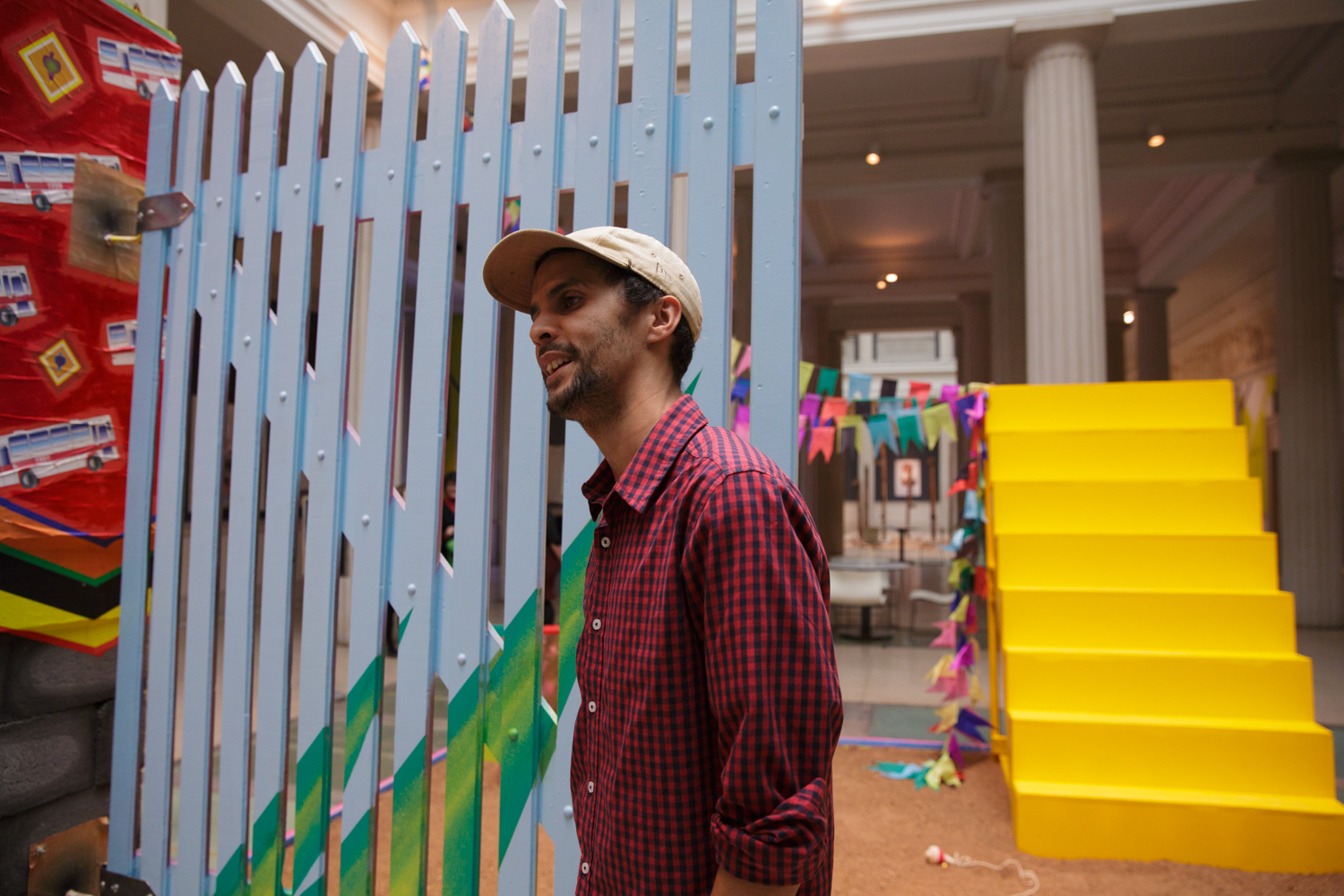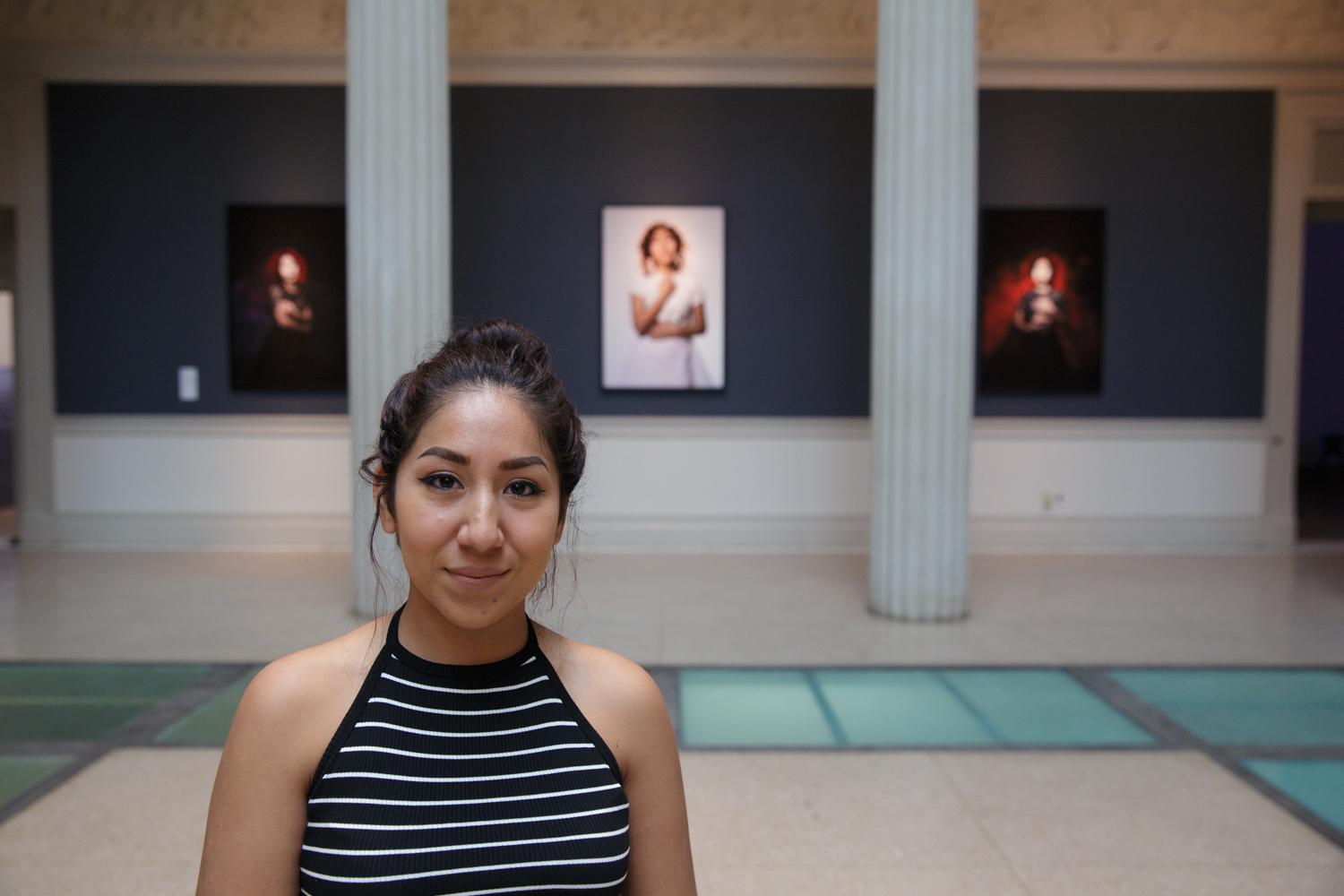By Menachem Wecker
Standing in front of his poster in the Corcoran School of the Arts and Design’s exhibit “NEXT,” GW senior Anders Larsson couldn’t help but let his mind wander back three years to the 2013 iteration of the annual student exhibit. The Swedish native and graphic design major had been so impressed by the prospect of his work hanging in the historic Flagg Building that it helped sell him on studying at the Corcoran.
“I was just blown away that everyone was showing in this building. I thought that’s crazy,” said Mr. Larsson, whose work explores randomness in the typically rigid discipline of typography. “It’s really exciting to be in this legacy space.”
Mr. Larsson’s poster, titled “On Randomness and Typography,” at first appears to be abstract. But upon further inspection, viewers can make out the word “Control” in thick black lines. More legible and smaller red text adds: “An element of randomness can push the form and layout of typography into unexpected and visually intriguing terrain.”
That sentence, which Mr. Larsson penned, became a self-fulfilling prophecy of sorts. His poster hangs beside a classmate’s that addresses Swiss design. “This is basic, but not simple,” the adjacent poster states in a white square within a larger red field; the emblematic white cross from the Swiss flag appears several times on that poster.
“My using black and white and red in my poster is a little bit of a flirt with the Swiss typography and design that you see to the left,” Mr. Larsson said. “Red, black and white are the colors traditionally used in Modernist design. Those things just happen, and it’s interesting to see.”
Not only was that unexpected juxtaposition further reinforcement of Mr. Larsson’s project, which suggests that nothing in design is truly random, but it also was a microcosm of the larger exhibit. Although the works in the exhibit reflect students’ thesis projects, patterns emerge in style, subject matter and a variety of other areas as one wanders through the galleries.
Mr. Larsson is one of 49 undergraduate students currently exhibiting in NEXT, an annual exhibit that began in 2011. On April 20, graduate students’ works will be added to the show, which opened on April 6 and closes on May 15.
“NEXT gives shape to the future of culture as seen through the lens of graduating students at the Corcoran School,” said Sanjit Sethi, director of the Corcoran School of the Arts and Design. “Their work offers insight into a world of diverse perspectives and disparate systems, which are in fact intricately connected. The displayed work is the result of a tremendous degree of creative investment and is the culmination of a curriculum that prepares students to be engaged artists, designers, critical thinkers and community builders.”
When visitors enter the building, they’re likely to first encounter Johab Silva’s “On the further side of,” a mixed-media installation that reflects the artist’s upbringing in Brazil. Although Mr. Silva has many distinct memories of the sounds, smells and tastes of the poor community he grew up in, which he calls “magical,” he sees the installation as a vehicle for figuring out why he grew up as he did. In a posted artist’s statement, he refers to “refabricating one’s memories.”
To complete his project, which Mr. Silva said took four months to conceive and construct, he logged onto Craigslist to find homeowners willing to share free dirt with him, and he rented a UHaul truck to drive to two homes in Virginia to retrieve the dirt; it was a priority for him to get to know the dirt donors. After lugging 30 bags of dirt to the Corcoran, where he strained them to make sure there was consistent color. That dirt forms the basis of the installation, which sits inside what resembles a large sandbox, made of plastic and wood.
“I ended up inviting those people to come see their dirt,” Mr. Silva said, noting that dirt to him evokes African and South American streets, where shoeless kids play soccer.
Throughout the rest of the installation, Mr. Silva built things that reflect his childhood, from toys (the first time he’s ever built his own toys, which he played with before installing) to a gate (which he welded) and a tower of cement blocks (he added broken glass at the top, echoing the barbed-wire substitute he grew up seeing).
“Everything is from scratch,” he said.
A photographic triptych by Carol Antezana hangs on a wall across the hall from Mr. Silva’s installation, and her work addresses trauma, such as the loss of a child. “How do you mourn a loss that you’ve never physically had memories with?” Ms. Antezana asks.
Ms. Antezana’s series, titled “Lamentation,” draws on the history of postmortem photography, and she uses herself as the model for the works. The Latina photographer’s parents come from Bolivia, and yet she notes that she is heavily inspired by Western art. “There are all these subconscious labels,” she said.
Around the corner from the triptych, photojournalism major Madison Richeson’s book of photographs is presented alongside prints of three drawings by her friend and Corcoran classmate Tyree Brown, who was paralyzed in a car accident last May. Ms. Richeson’s photographs track Ms. Brown’s recovery and resiliency. Ms. Richeson tries, she explains, to demonstrate what the aftermath of an accident is like without exploiting it.
“A lot of people aren’t familiar with it. It makes them uncomfortable. A lot of people think it’s the end of one’s life -- that’s just a really big misconception of people with disability and injury in general,” Ms. Richeson said. “That’s something we’re both trying to fight against.”
The photographer has gone to church several times with Ms. Brown and observed how much the latter’s faith and family have helped her cope with the psychological challenges that are caused by such a painful and destructive accident.
“It’s really been a journey for her,” Ms. Richeson said.






